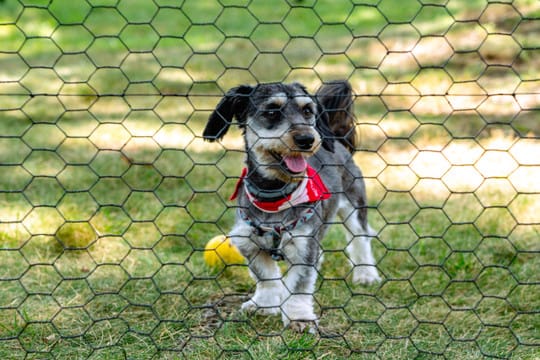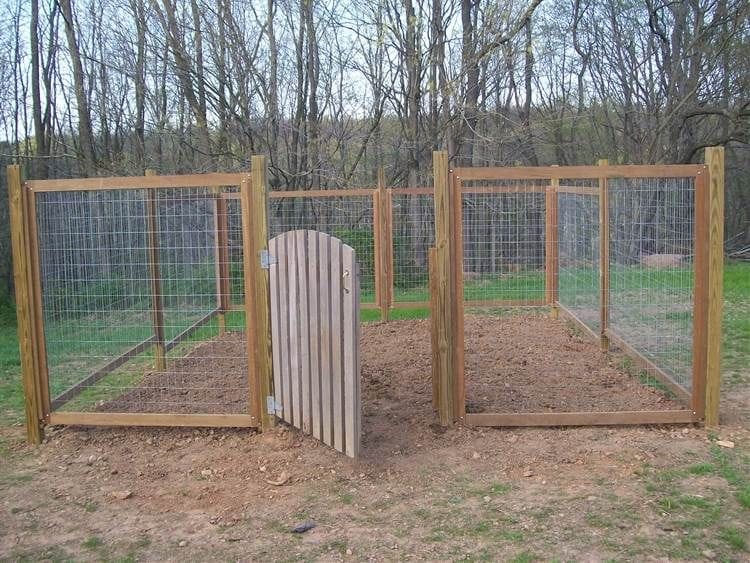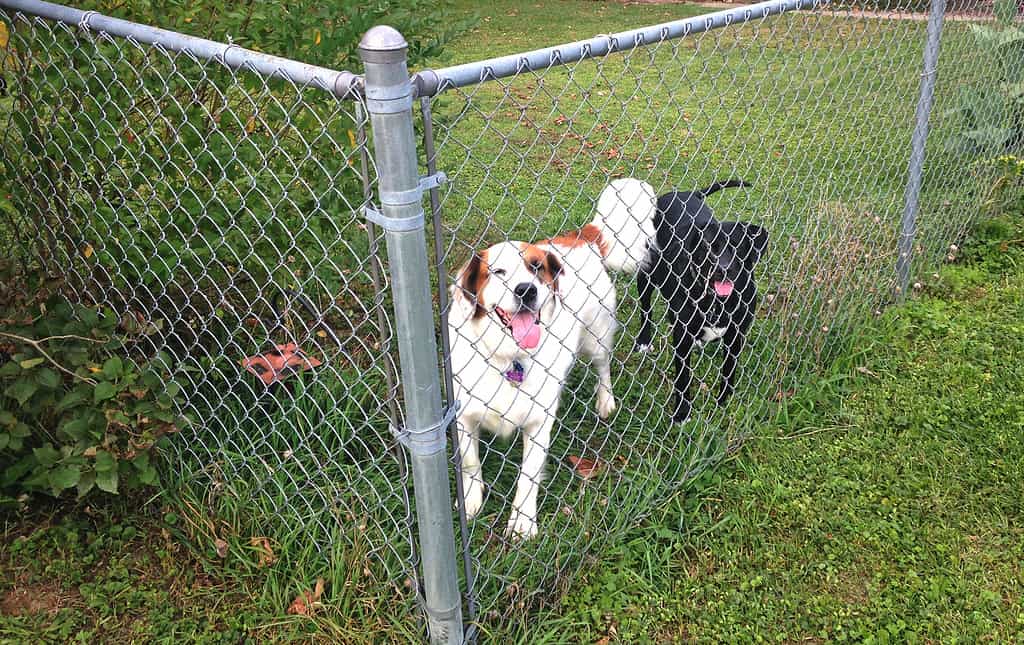Dog owners often face the challenge of keeping their furry friends contained within their property. While traditional fences may be effective, they can be expensive and require a lot of maintenance. Fortunately, there is an alternative solution: dog fence kits.

Dog fence kits are a cost-effective and easy-to-install option for pet owners who want to keep their dogs safely contained within their property. These kits typically include a transmitter, receiver, and boundary wire that can be buried underground or attached to an existing fence. The transmitter emits a radio signal that is picked up by the receiver on the dog's collar, which emits a warning beep and/or a mild static correction when the dog approaches the boundary line.
There are many different types of dog fence kits available on the market, each with its own unique features and benefits. Some kits are designed specifically for small dogs, while others are suitable for larger breeds. Some kits are wireless, while others require the boundary wire to be buried underground. Whether you have a small backyard or a large property, there is a dog fence kit that can meet your needs and keep your furry friend safe and secure.

Understanding Dog Fence Kits
Dog fence kits are a popular choice for pet owners who want to keep their dogs safe and contained within a specific area. These kits come with everything you need to install a fence, including ground stakes, fencing material, gates, and other components.
Components of a Dog Fence Kit
A typical dog fence kit includes several components that work together to create a secure and effective barrier. These components may include:
- Fencing Material: Dog fence kits may include polypropylene mesh, welded wire mesh, or coated wire fencing solutions. The type of fencing material you choose will depend on your specific needs and preferences.
- Ground Stakes: Ground stakes are used to secure the fencing material to the ground. They are typically made of durable materials like steel or aluminum.
- Coating: Some dog fence kits come with a coating that helps to protect the fencing material from the elements. This coating may be made of PVC, vinyl, or other materials.
- Gates: Many dog fence kits come with gates that allow you to enter and exit the fenced area. These gates may be made of the same material as the fencing or may be constructed from other materials like wood or metal.
Types of Dog Fences
There are several types of dog fences to choose from, each with its own advantages and disadvantages. Some of the most common types of dog fences include:
- Electric Dog Fences: Electric dog fences use a buried wire and a collar that emits a warning tone or a mild shock to keep dogs within the designated area. These fences are often less expensive than traditional fences, but they require more training and maintenance.
- Real Dog Fences: Real dog fences are more traditional fences made of materials like wood, vinyl, or metal. These fences provide a more secure and durable barrier, but they can be more expensive and time-consuming to install.
- Dog Fence Rolls: Dog fence rolls are a type of fencing material that is designed specifically for use with dogs. These rolls may be made of polypropylene mesh, welded wire mesh, or other materials, and they are typically easy to install and maintain.
Overall, dog fence kits are an excellent option for pet owners who want to keep their dogs safe and contained within a specific area. By understanding the components of these kits and the different types of dog fences available, you can make an informed decision about which type of fence is right for you and your furry friend.
Planning Your Dog Fence
When it comes to planning a dog fence, there are a few important factors to consider. By taking the time to carefully plan and choose the right materials, you can create a safe and secure space for your furry friend to play and exercise.
Determining the Perimeter
The first step in planning your dog fence is to determine the perimeter of the area you want to enclose. This will depend on the size of your yard and the amount of space you want to give your dog to run around in. Measure the linear feet of your yard and decide where you want to place the fence.
Choosing the Right Height and Material
Once you have determined the perimeter of your dog fence, the next step is to choose the right height and material. The height of your fence will depend on the breed of your dog and their jumping ability. For larger breeds, a fence that is at least 6 feet tall is recommended. For smaller breeds, a fence that is 4-5 feet tall may be sufficient.
When it comes to materials, there are a few options to choose from. Galvanized steel is a popular choice for its strength and durability. It is also customizable, allowing you to choose the height and style that best suits your needs. Other materials, such as vinyl or wood, may be more flexible and offer a more aesthetically pleasing look.
It is also important to consider the breaking strength of your dog fence. This will ensure that your fence is strong enough to contain your dog and prevent them from escaping. A barrier with a high breaking strength, such as galvanized steel, is recommended for larger breeds or dogs with a tendency to chew or dig.
By taking the time to carefully plan and choose the right materials, you can create a safe and secure space for your dog to enjoy. Whether you opt for galvanized steel or another material, a well-built dog fence can provide peace of mind and a happy home for your furry friend.
Installation Guide
Step-by-Step Installation
Installing a dog fence kit is a relatively straightforward process that can be done by most DIY enthusiasts. The following is a step-by-step guide to help you install your DIY dog fence kit.
- Start by marking out the perimeter of your fence using flags or stakes. This will help you visualize where the fence will go and ensure that you have enough materials to complete the job.
- Dig holes for the fence posts using a post hole digger. The depth of the hole should be at least 2 feet to ensure that the fence is secure. If you are using ground sleeves, make sure to install them before placing the fence posts.
- Place the fence posts in the holes and fill the holes with concrete. Make sure that the posts are level and plumb before the concrete sets.
- Once the concrete has set, attach the fence mesh to the posts using hog rings and a hog ringer tool. Make sure to overlap the fence mesh at the corners and gate openings for added stability.
- Install the gate posts and attach the gate hardware according to the manufacturer's instructions.
- Finally, test the fence to ensure that it is secure and functioning properly. You can do this by walking around the perimeter of the fence and checking for any weak spots or areas where the fence may need to be tightened.
Tools and Hardware Required
To install a DIY dog fence kit, you will need the following tools and hardware:
- Post hole digger
- Concrete mix
- Fence mesh
- Fence posts
- Gate posts
- Gate hardware
- Hog ringer tool
- Hog rings
- Driving cap (optional)
- Ground sleeves (optional)
Make sure to read the manufacturer's instructions carefully before starting the installation process to ensure that you have all the necessary tools and hardware.
Safety and Containment

Ensuring a Safe Enclosure
When it comes to dog fence kits, safety is a top priority. It's important to choose a kit that is safe for your pets and other animals that may come into contact with the fence. Look for a kit that has been tested and certified as safe for animals.
In addition, it's important to ensure that the fence is installed correctly and securely. A poorly installed fence can pose a safety hazard to your pets and other animals. Make sure that the fence is installed at the correct height and that there are no gaps or holes that your pets can escape through.
Preventing Escapes and Intrusions
Dog fence kits are designed to keep your pets contained, but some dogs are escape artists and can find ways to get out of even the most secure enclosures. To prevent escapes, look for a fence kit that is anti-climb and difficult to jump over or dig under.
It's also important to consider the type of animals that may try to enter your yard. A dog-proof fence kit can help prevent other animals from entering your yard and potentially harming your pets.
For temporary enclosures, a dig guard can be a useful tool to prevent your pets from digging under the fence.
Overall, a humane and secure dog fence kit can provide peace of mind and keep your pets safe and contained.
Maintenance and Durability
Regular Maintenance Tips
To ensure the longevity of a dog fence kit, regular maintenance is crucial. One of the most important things to do is to check for any gaps or holes in the fence. These can be caused by weather conditions, digging, or other factors. If any gaps are found, they should be repaired immediately to prevent the dog from escaping or other animals from entering the property.
Another important aspect of maintenance is to keep the fence clean. Dirt and debris can accumulate on the fence, which can cause damage over time. To clean the fence, use a mild detergent and a soft brush. Rinse the fence thoroughly with water and allow it to dry completely before allowing the dog to use the area.
Long-Term Durability
The durability of a dog fence kit depends on the quality of materials used and how well it is installed. High-quality materials such as aluminum or steel are more durable and stable than cheaper materials like plastic. Additionally, a properly installed fence will be more stable and less likely to become damaged over time.
Another factor that can affect the durability of a dog fence kit is the climate. Extreme weather conditions such as high winds or heavy rain can cause damage to the fence. To prevent this, it is important to choose a fence that is suitable for the climate in which it will be installed.
In conclusion, regular maintenance and choosing a high-quality, suitable fence are key to ensuring the longevity and durability of a dog fence kit. By following these tips, pet owners can provide a safe and secure environment for their furry friends.
Additional Features and Considerations
When it comes to dog fence kits, there are a variety of additional features and considerations that pet owners should keep in mind. Here are some of the most important factors to consider before making a purchase.
Customization and Expansion
One of the key benefits of many dog fence kits is the ability to customize and expand the system to meet the specific needs of your pet and property. Some kits offer options for adjusting the height and length of the fence, as well as adding climb protection to prevent escape attempts. Additionally, many kits can be expanded to cover larger areas or accommodate multiple pets.
Accessories and Enhancements
In addition to the basic fence components, many dog fence kits also come with a variety of accessories and enhancements. These can include gates for easy access, training flags to help your pet learn the boundaries, and even free shipping to help keep costs down. Some kits may also offer additional features like chain link fencing for added durability and security.
Overall, when selecting a dog fence kit, it's important to carefully consider your pet's needs and your property's layout to ensure that you choose the right system. By taking the time to weigh your options and explore the various customization and enhancement options available, you can find a fence that will keep your pet safe and secure for years to come.

Cost and Value
Affordable Fencing Options
When it comes to dog fence kits, there are a variety of affordable options available. These kits typically include everything you need to get started, such as the fence panels, posts, and hardware. Some affordable options may also include gates and other accessories to make installation and use easier.
One important thing to keep in mind when considering affordable options is the quality of the materials. While some cheaper kits may be tempting, they may not be made from durable materials that can withstand the elements or the wear and tear of your dog. It's important to find a balance between affordability and quality to ensure that you get the best value for your money.
Investing in Quality
Investing in a high-quality dog fence kit may cost more upfront, but it can provide long-term value and peace of mind. Quality kits are typically made from durable materials that can withstand the elements and the wear and tear of your dog. They may also come with features such as rust-resistant coatings or UV protection to help extend the life of the fence.
In addition to durability, high-quality dog fence kits may also be easier to install and maintain. Some kits may include features such as pre-assembled panels or simple installation instructions to make the process easier for you. This can save you time and money in the long run, as you won't have to constantly repair or replace your fence.
Overall, when considering cost and value, it's important to weigh the benefits of affordability versus quality. While affordable options may be tempting, investing in a high-quality dog fence kit can provide long-term value and peace of mind.
Special Considerations
Dealing with Different Dog Behaviors
When it comes to choosing a dog fence kit, it is important to consider your dog's behavior. For example, if your dog is a jumper, you will need a fence that is high enough to prevent them from jumping over it. If your dog is a chewer, you will need a fence that is made of materials that are resistant to chewing.
Fencing for Specific Breeds
Different dog breeds have different needs when it comes to containment. For example, some breeds are more active and require more space to run around in, while others are more relaxed and don't require as much space. It is important to choose a fence that is appropriate for your dog's breed and size.
Coyote Prevention and Wildlife
If you live in an area where there are coyotes or other wildlife, it is important to choose a fence that is designed to prevent them from getting into your yard. This can include features such as a coyote roller or a fence that is buried underground to prevent digging.
In summary, choosing the right dog fence kit requires careful consideration of your dog's behavior, breed, and the wildlife in your area. By taking these factors into account, you can ensure that your pet is safe and secure in your yard.
Frequently Asked Questions

- Q1: What type of fence is most effective for containing large dogs?
- The most effective fence for large dogs is a sturdy, tall physical fence made of materials such as wood, vinyl, or metal. Chain-link fences are not recommended for large dogs as they can easily climb or jump over them. It's important to ensure that the fence is at least 6 feet tall and has no gaps or holes that the dog can escape through.
- Q2: How can I find affordable dog fence kits?
- Affordable dog fence kits can be found online or at local pet stores. It's important to do research and compare prices before making a purchase. Some websites offer discounts or promotions on dog fence kits. Another option is to consider DIY dog fence kits, which can be more cost-effective than hiring a professional to install a fence.
- Q3: What are the advantages of wireless dog fences compared to traditional fencing?
- Wireless dog fences are a popular alternative to traditional fencing because they are less expensive and easier to install. Wireless fences also allow for more flexibility in terms of placement and can be used in areas where traditional fencing may not be allowed or practical. However, it's important to note that wireless fences may not be as effective as physical fences for containing dogs, as they rely on the dog's willingness to obey the boundary.
- Q4: What are some creative dog fencing ideas for outdoor spaces?
- Some creative dog fencing ideas for outdoor spaces include using natural barriers such as hedges or bushes, installing a decorative fence that complements the landscaping, or using a combination of physical and wireless fencing. It's important to ensure that any fencing used is secure and able to contain the dog.
- Q5: How tall should a fence be to ensure a dog cannot jump over it?
- To ensure a dog cannot jump over a fence, it should be at least 6 feet tall. However, some large breeds may be able to jump higher than this, so it's important to consider the individual dog's abilities when choosing a fence height.
- Q6:What are the best temporary fencing solutions for dogs?
- Temporary fencing solutions for dogs include portable dog fences, playpens, and outdoor kennels. These options are easy to set up and can be moved or taken down as needed. It's important to ensure that any temporary fencing used is secure and able to contain the dog.




